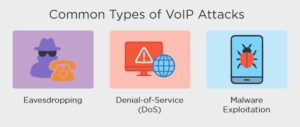Voice over Internet Protocol (VoIP) technology is advancing and becoming a more popular medium of communication today. It enables us to make voice calls over the internet rather than conventional telephone lines. Nevertheless, the open networks and internet protocols on which VoIP is based predispose it to cyber threats. This is why VoIP security is essential. It can prevent you from incoming threats and attacks.
In this blog, we will discuss VoIP technology, its security vulnerabilities, and best practices to keep your voice communication secure.
Knowing VoIP Technology
VoIP technology uses the session initiation protocol (SIP) and the real time transport protocol (RTP) to set and control voice calls. The VoIP systems can be thought of as not being confined to closed systems, as are seen in the traditional telephone systems, but rather the voice information flow is carried over IP networks.
Some of the prime benefits are flexibility and cost savings, but on the other hand, it puts organizations at risk of cyberattacks. As VoIP packets are routed through multiple network nodes before they reach the destination:
The following are some of the common types of VoIP attacks:
Eavesdropping: In this type of attack, attackers intercept calls and eavesdrop on conversations.
Denial-of-Service (DoS) Attacks: Attackers flood the system with traffic. This may disrupt the complete network.
Malware Exploitation: Endpoints or VoIP servers can be exploited by malicious software.
The above weak points have been at the center stage of VoIP security, as anyone can fall victim to these attacks, leading to financial, data, and business losses.
Sharing Common VoIP Security Weaknesses
Weak Passwords and One-Factor Authentication: Easily broken passwords may be easily hacked into, and accounts where the multi-factor authentication is not applied are under high risk.
Unnoticed Call Traffic: This may not show any sign of unusual call patterns or attempts of unauthorized access unless the system is monitored.
Absence of Proper Access Controls: Uncontrolled Access to Sensitive VoIP features is a major threat.
Weak Remote Access: Workers can also work over public Wi-Fi or unsecured network which can be used by attackers as a point of entry.
Best Practices for VoIP Security
Following are some of the most effective VoIP security best practices:
Powerful Passwords and Multi-Factor Authentication (MFA)
It is necessary that all user accounts are strong passwords, which are not only complex but also unique and consist of lowercase and uppercase letters, numeral and symbol combinations.
Multi-factor authentication would serve as another assurance since the user would be required to validate his/her identity in a second factor i.e., a one-time code sent to a phone. The access is not simple even in case the passwords have been hacked.
State-of-the-Art Software and Systems
The software, firmware and other associated systems of VoIP must be updated regularly to cater to the known vulnerabilities. Automate as much as possible or a calendar of updates.
Follow-up Call Records and Statistics
-
- Keeping a check on VoIP call logs can help in the early detection of suspicious activity. Look for anomalies such as:
- A large number of calls to international or premium-rate numbers.
- Out of regular business hours calls.
- Incoming calls with unknown IP addresses.
Educate and Train Your Staff
VoIP security threats often rely on employees as the first line of defense. Train them to:
-
- Identify social engineering attacks such as vishing.
- Check identities before disclosing confidentiality.
- Report any suspicious activity.
- A culture of security training fosters a security-conscious culture that enhances organizational protection.
Backup and Test Restore Processes
Frequent VoIP configurations, user data backups, and call log backups will ensure that the business continues to operate in the event of a breach. Tests restore systems periodically to ensure your system can be restored within hours following a security incident.
Final Words!
VoIP technology is highly flexible and efficient for contemporary businesses; however, it also presents security issues that cannot be ignored. VoIP vulnerabilities are a threat, starting with weak passwords and untracked traffic, as well as DoS attacks and spoofing.
Adopting the best security practices of VoIP, such as the use of strong passwords, MFA, updates, monitoring of traffic, and employee training, can surely help. Alongside, you can even choose a reliable VoIP security provider, your gateway to voice security starts here!
For more blogs on the cybersecurity landscape, visit us here. We’ve got you covered!
FAQs
Q1] Are VoIP phones secure?
Ans: VoIP is not just vulnerable to eavesdropping, voicemail hacking, and toll fraud. You can use IP phones as gateways to your company's network.
Q2] What is the disadvantage of VoIP?
Ans: The main disadvantage of VoIP is, it relies on internet connection.
Recommended For You:
Voice Recognition Technology in Cybersecurity: Enhancing Compliance and Security Measures






